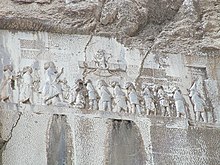Gobryas (father of Mardonios)
Gobryas ( Old Persian: Gaubaruva , Elamite: Kambarma ), son of Marduniya, was a Persian nobleman of the Achaemenid Empire in the 6th century BC.
Conspirators
Gobryas was in the year 522 BC. BC next to Otanes , Ardumaniš , Intaphrenes , Hydarnes , Megabyzos and Dareios one of the seven conspirators against the usurper Gaumata . Along with Ardumaniš, he was one of the first to be initiated by Otanes into the secret usurpation of the Persian throne by the magicians . He then inaugurated the megabyzos. During the fight in the royal apartments Gobryas threw himself on Gaumata and is said to have been ready for self-sacrifice by asking Dareios to pierce him with the sword in order to also hit the Gaumata. But Darius was able to kill the usurper without having to injure Gobryas.
After the successful change of power, Gobryas proposed in 520 BC. BC put down the revolt of the Elamites . After that he is once again participating in the campaign against the Scythians on the Danube in 513 BC. Called BC. For the last time, Gobryas is dated to the year 498 BC. Called a clay tablet from Persepolis that can be dated to BC .
At the court of Darius I, Gobryas had assumed one of the highest honors. He is immortalized at the king's tomb in Naqsch-e Rostam in the function of the royal “lance-bearer” ( arštibara ). The depiction of the lance-bearer in the relief to the famous Behistun inscription (see picture) is also attributed to him. He was probably in command of the guard corps of the " apple bearers ".
Origin and family
The relief of the Gobryas on the grave of Naqsch-e Rostam is described as follows: "Gobryas of Pâtišuvariš , the lance-bearer of King Darius." Possibly he belonged to the ethnic group of the Pateischoreiner described by Strabon , who are a sub-tribe of the Persians in close association with the Achaemenids formed.
As the only one of the conspirators, Gobryas had already before the overthrow in 522 BC. Chr. In a close relationship to Dareios I, which certainly explains his motivation to participate in the conspiracy. The first wife of Darius was a daughter of his and the three first sons of the Great King ( Artobazanes , Ariamenes , Ariabignes ) were consequently his grandchildren. After the coup, Gobryas married a sister of Dareios who gave birth to Mardonios († 479 BC). He in turn was eventually married to a daughter of Darius, Artazostre .
The descendants of Gobryas were one of the families of the so-called "seven Persians" of the Persian nobility, the descendants of the seven conspirators (including Darius). Other known descendants apart from Mardonios cannot be ascribed to him.
literature
- Josef Wiesehöfer: Ancient Persia. From 550 BC BC to AD 650. Albatros, Düsseldorf 2005, ISBN 3-491-96151-3 .
- Pierre Briant : From Cyrus to Alexander. A History of the Persian Empire. Eisenbrauns, Winona Lake 2002, pp. 108-109, 112-113, 135-136.
Remarks
- ↑ Behistun-Inscription (DB), plate 4, §68 in: Roland G. Kent, Old Persian-Grammar Texts Lexicon . American Oriental Society, 1953. Herodotus , Historíai . 3, 70. In the apparently flawed tradition of the Ktesias ( FrGrHist. No. 688, Question. 13, 16 [based on the edition by Lenfant ]) Mardonios is named as one of the conspirators. Here father and son were mistaken for one another.
- ↑ Herodotus, Historíai. 3, 78.
- ^ Behistun inscription (DB), panel 5, §71.
- ↑ Herodotus, Historíai. 4, 132 and 134.
- ↑ See Briant, p. 112.
- ^ Heinz Luschey: Studies on the Darius relief from Bisutum. in: Archaeological communications from Iran. Vol. 1 (1968), pp. 63-94.
- ↑ Strabon 15, 3, 1. See Briant, pp. 108-109.
- ↑ See Briant, p. 113.
- ↑ Herodotus, Historíai. 7, 2.
- ↑ Herodotus, Historíai. 7, 5.
- ↑ Herodotus, Historíai. 6, 43.
Web links
| personal data | |
|---|---|
| SURNAME | Gobryas |
| ALTERNATIVE NAMES | Gaubaruva (old Persian); Kambarma (Elamite) |
| BRIEF DESCRIPTION | Army leaders in ancient Persia |
| DATE OF BIRTH | 6th century BC Chr. |
| DATE OF DEATH | 5th century BC Chr. |
